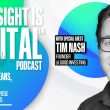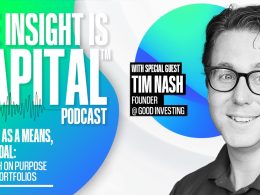As the dust settles on another round of trade turbulence between Canada and the United States, following the Trump White House’s Rose Garden address on global reciprocal tariffs, advisors across the country are once again seeking clarity amidst chaos. In a recent episode of Discovery Series Unplugged1, Desjardins’ Deputy Chief Economist, Randall Bartlett, breaks down the reality behind the headlines—and what it all means for the economy, markets, and, ultimately, the clients advisors serve.
This sweeping conversation marries economic insight with pragmatic direction, tailor-made for advisors navigating this period of deep uncertainty. Here’s what you need to know—and how to translate it into informed, future-ready planning.
Understanding the Trade War: Why Tariffs Are Back
Bartlett is frank in his assessment when it comes to pointing out the root of the current tariff escalation:
“Overall, the reason… is really a desire to bring back manufacturing to The United States. I think fundamentally that’s what it comes down to”.
But as Bartlett notes, this nostalgia for the Rust Belt’s heyday doesn’t match today’s labor dynamics. Automation—not globalization—has been the biggest driver of manufacturing job losses. And bringing production back to the U.S., he warns, “tend[s] to be very advanced manufacturing, hiring more engineers and software developers than laborers.”
That means the policy doesn’t just fall short of helping workers—it actually harms them.
“There’s research by the Federal Reserve that found… all of these tariffs and reciprocal tariffs… led to a net decline in employment and manufacturing in the US.”
Who Really Pays? The Consumer.
When it comes to cost, Bartlett is unequivocal: “Ultimately, at the end of the day, it’s the consumer or the investor or both who ends up paying the cost of it.”
“I do see a significant impact of the tariffs on Americans' day to day lives,” explains Bartlett..” I think when you look at not just the imports from Canada, but the tariff imports from China, which make up a larger part of the goods that Americans consume on a day to day basis, from the European Union, Mexico, and elsewhere, it's going to have a massive impact on Americans' cost of living. It’s going to erode affordability for most Americans. And coming out of the pandemic, many Americans have already chewed through the excess savings that they built up during the pandemic. That's something that Canadians or Europeans haven't done.”
Economic Fallout on Both Sides of the Border
From an economic modeling standpoint, the ripple effects are substantial:
In the U.S.: “We’re already seeing the U.S. economy weakening just because of uncertainty… that reduces business investment… reduces employment… and drives up inflation”.
In Canada: “We’re expecting to see weakness across the board in the Canadian economy. So a recession in the truest sense of the word”.
And it's not just macroeconomic abstractions. Bartlett points to sharp pullbacks in consumer spending, delayed business investment, and risk aversion among investors.
“Canadians are building up savings in the event they might lose their jobs… Businesses are putting investment on the shelf”.
This is not a theoretical risk—it’s happening now.
Tariff Impacts by Sector: Where the Pain Hits Hardest
Tariffs aren’t just macro-level headwinds; they’re industry-specific gut punches. According to Bartlett:
- Mining and Mineral Products: Especially steel and aluminum, with added costs creating margin compression.
- Manufacturing: Ontario, Quebec, and Manitoba face acute pressure, with Bartlett noting that autos are “one third of Ontario’s exports to the US”.
- Autos: Particularly vulnerable due to integrated supply chains—“components cross international borders roughly eight times” during car production.
Tracking country-of-origin paperwork is becoming a logistical and compliance nightmare, and “it’s going to get even messier going forward.”
For advisors with clients in manufacturing, logistics, or export-reliant businesses, now is the time to model stress scenarios, explore contingency financing, and plan around prolonged sector volatility.
Can Tariffs Achieve Their Goals?
Even assuming optimal political execution, the answer seems to be no. “It could take… up to a decade… to really see a material change in supply chains… [and] tens of billions of dollars in additional investment… that didn’t need to happen”.
In other words, the cost of achieving the goal far outweighs the benefit—and may never deliver the jobs or self-sufficiency intended.
Canadian Response: Holding the Line (For Now)
With Parliament on hiatus, Ottawa’s hands are tied. But Bartlett says the provinces have stepped up, announcing over $30 billion in contingencies to support households and businesses.
“We’re ragging the puck until we’ve got all of our players on the ice,” Bartlett remarks, describing the federal approach as one of strategic delay while provinces test new policy responses.
He also acknowledges the rise of “Team Canada” patriotism—consumers buying Canadian, avoiding U.S. travel, and lobbying through economic behavior. “It sends a very clear signal… to Americans, to American businesses… Canadians aren’t going to take this lying down”.
Inflation Outlook: Surprisingly Stable—for Now
Despite the inflationary nature of tariffs, Bartlett expects a measured impact thanks to offsetting factors like the carbon tax rollback and past GST/HST relief. “Our latest forecast suggests that we could end the year with inflation around 2.5%… even though we have all of these different shocks buttressing inflation”.
Translation: There may be short-term pain at the grocery store, gas pump, or in consumer goods—but no return to 2022-style runaway inflation.
Trade Relations and the Bigger Picture
One of the most poignant takeaways from the conversation was Bartlett’s assessment of the Canada-U.S. trade relationship:
“We’ll always trade with the Americans… [but] the uncertainty… will fray that relationship over the longer term… If you don’t have the trust maintained between two parties, there’s no agreement”.
For Canadian businesses and advisors alike, this is a call to diversify—not just portfolios, but trade routes, supply chains, and economic dependencies.
Housing Market: Headwinds and Hope
With population growth slowing, mortgage renewals rising, and trade uncertainty increasing unemployment risk, the outlook for housing is tepid. “We think that sales activity is going to weaken… We are looking out for a period of weakness overall in the Canadian housing market”.
But there's a silver lining in rental development:
“One of the positives too that we've seen in the last little while is that rental housing starts, rental construction, has now surpassed condo construction in Canada as well as single detached homes,” says Bartlett. ”So a lot of the measures that the federal Liberals brought into place to help spur construction of purpose-built rentals seems to be effective. We're seeing a lot more investment in that space. Ultimately, on the rental side, certainly, we could see some positive news for Canadians' wallets going forward.”
For investors, this creates a potential window of opportunity in purpose-built rental assets as affordability pressures steer demand toward lease-based living.
Stimulus: Not Like 2020
What about a stimulus package?
“I don’t see us having COVID-style stimulus… It’s really going to be more focused on providing sustained support for the structural change in our economy”.
Advisors should prepare clients for selective, infrastructure- and trade-focused government spending—not blanket cash transfers or debt-fueled injections.
Final Thoughts: A Long-Term Lens for Uncharted Waters
Bartlett closes the conversation with a message advisors can take straight to their clients’ planning conversations:
“We are obviously going through a period of unprecedented uncertainty… But ultimately, we continue to see that financial returns continue to rise over time… It’s about having that long-term vision in mind”.
In a word, his 2025 forecast?
“Challenging. Resilient. Change. And it will end”.
Advisor Action Points
1. Prepare clients for volatility.
- Tariffs are here—and so are the knock-on effects to inflation, employment, and confidence.
2. Diversify exposure.
- Whether geographic, sectoral, or asset-class based, the old North American binary may no longer be enough.
3. Focus on real economy implications.
- Clients in autos, manufacturing, housing, or consumer goods may require scenario planning.
4. Watch provincial and trade policy updates.
- Federal tools are limited, but regional actions and international diversification could present opportunity.
5. Reassure clients with long-term context.
- Volatility is not new—but the ability to endure it remains timeless advice.
At this time of heightened uncertainty, advisors are uniquely positioned to help their clients stay calm, stay strategic, and stay on course. Because while tariffs may come and go, well-informed financial advice will always be in demand.
For additional economic insights, see Desjardins’ latest forecast3. The next update will be on April 25, 2025.
Footnotes:
1 "Discovery Series unplugged with Desjardins | Webi." 5 Apr. 2025, www.webi.desjardinsassurancevie.com/en/public/insurance/Pages/discovery-series-unplugged-desjardins.a spx.
2 "Discovery Series: Unplugged." Spotify, 5 Apr. 2025, open.spotify.com/episode/79aA1r4gKhbLYE5LDc9sxn.
3 "A Recession is Likely as Trade War Impacts Loom." Desjardins, 20 Mar. 2025, www.desjardins.com/qc/en/savings-investment/economic-studies/economic-financial-outlook.html.














